Part 2: Forecast statement of service performance for each of the three years 2013/14, 2014/15, and 2015/16
Output class: Audit and assurance services
The main purpose of an annual audit is to provide independent assurance about the fair disclosure of the financial – and, in many instances, non-financial – information within annual reports. We also use our annual audits to gather information and knowledge about public entities to assist us in advising Parliament and other stakeholders.
Public entities responding to their statutory public reporting obligations and to findings resulting from audits is fundamental to trust in the public sector. The approach of public entities to public reporting and their responses to audit recommendations help demonstrate their commitment to effective, efficient, and accountable service delivery.
In 2013/14, our annual audits and other assurance services are expected to account for 88% of our total expenditure. The major portion of this output class relates to annual audits of public entities that are required by statute to be carried out. Other work carried out under this output class includes the three-yearly audits of local authority long-term plans and various other assurance work that complements the annual audits of public entities.
For 2013/14, the Office proposes to focus on public sector service delivery, and we intend to consider aspects of this theme during our annual audits and other assurance work. We intend to use the information we gather to help inform other parts of our future work programme and our reporting, and feed into planning for our annual audits in 2014/15 and 2015/16.
Our annual audits
The Auditor-General is the auditor of every public entity in New Zealand, and is required to audit the information those entities produce that is subject to an audit requirement. Our audits provide an audit opinion on whether the financial statements (and, where applicable, the performance information) fairly reflect the public entity's performance and financial position. The management report sets out any significant issues identified by the auditor during the audit and, where relevant, provides recommendations for improving the public entity's controls, systems, and processes.
We expect to carry out audits for 3876 entities for the 2013/14 financial year.5 This includes the audits of 3854 public entities that produce financial statements (and, in some cases, non-financial performance information). A summary of our current audit portfolio is shown in Figure 10.
Figure 10
Summary of our current audit portfolio
| Public service departments (29) and other government departments (6) | 35 |
| Small entities associated with other government departments* | 17 |
| Offices of Parliament** | 2 |
| District health boards (20), and their subsidiaries and other associated entities (28) | 48 |
| Tertiary education institutions (29), and their subsidiaries and other associated entities (113) | 142 |
| Crown research institutes (7), and their subsidiaries and other associated entities (27) | 34 |
| Schools (2458), and their subsidiaries and other associated entities (37) | 2495 |
| Other Crown entities (65)***, and their subsidiaries and other associated entities (92) | 157 |
| Organisations named or described in Schedule 4 of the Public Finance Act 1989 | 74 |
| State-owned enterprises (17), and their subsidiaries and other associated entities (86) | 103 |
| Other public entities in central government | 124 |
| Local authorities | 78 |
| Council-controlled organisations | 212 |
| Airports (19), and their subsidiaries and other associated entities (4) | 23 |
| Energy companies (25), and their subsidiaries and other associated entities (49) | 74 |
| Port companies (12), and their subsidiaries and other associated entities (22) | 34 |
| Licensing and community trusts (21), and their subsidiaries and other associated entities (20) | 41 |
| Cemetery trustees | 96 |
| Other public entities in local government | 65 |
| Total | 3854 |
* These are predominantly entities associated with the New Zealand Defence Force, such as Queen Elizabeth II Army Memorial Museum.
** These are the Office of the Ombudsmen and the Parliamentary Commissioner for the Environment. The Office of the Auditor-General is also an Office of Parliament, but the Auditor-General does not audit it.
*** These include autonomous Crown entities, Crown agents, Crown entity companies, and independent Crown entities.
![]() These include administering bodies, fish and game councils, and entities such as the Lottery Grants Board.
These include administering bodies, fish and game councils, and entities such as the Lottery Grants Board.
![]()
![]() These include the Reserve Bank, Government Superannuation Fund, National Provident Fund, Air New Zealand Limited, Southern Response Earthquake Services Limited, subsidiaries of those entities, and numerous smaller entities such as producer boards, registration boards, and rural education activity programmes.
These include the Reserve Bank, Government Superannuation Fund, National Provident Fund, Air New Zealand Limited, Southern Response Earthquake Services Limited, subsidiaries of those entities, and numerous smaller entities such as producer boards, registration boards, and rural education activity programmes.
![]()
![]()
![]() These include Watercare Services Limited, Civic Assurance Limited, New Zealand Local Government Association, Eden Park Trust Board, sinking fund commissioners, and numerous other entities associated with local authorities.
These include Watercare Services Limited, Civic Assurance Limited, New Zealand Local Government Association, Eden Park Trust Board, sinking fund commissioners, and numerous other entities associated with local authorities.
We also expect to carry out audits of the following:
| The financial statements of the Government | 1 |
| The Government of Niue, its subsidiaries and other associated entities | 9 |
| The Government of Tokelau | 1 |
| Entities the Auditor-General has agreed to audit under section 19 of the Public Audit Act 2001 | 11 |
| Total | 22 |
| The total number of entities we expect to carry out audits for in the 2013/14 financial year | 3876 |
In addition to annual audits, we expect to carry out an audit of summary financial statements (and, in some cases, summary performance information) for some of these entities. In particular, we are required to audit local authorities' summary annual reports. There are a few schemes and arrangements, such as the student loans scheme, that we separately audit each year.
We also carry out are a number of other engagements. These include:
- audits or other assurance for regulatory purposes, such as for the Department of Internal Affairs regarding licensing trusts, forecast financial statements, and the Commerce Commission regarding energy companies' electric power reliability;
- a review of the service performance of Auckland Council and its subsidiaries;
- audits or reviews of interim financial statements, particularly for public entities that are issuers; and
- assurance for trustees of debenture trust deeds, where public entities have borrowed funds from the public.
Our focus
In the next year, within our annual audit and assurance work, we will focus on:
- Responding to changes in accounting standards – We will continue to focus on making a positive contribution to the work of the External Reporting Board in setting and implementing accounting standards. In 2013/14, we will also help to prepare our auditors to audit in an environment of new accounting standards, which are expected to become effective in 2014/15.
- Performance information – We continue to phase in the Auditor-General's revised auditing standard on reporting non-financial performance information, and the standard now applies to our audits of most public sector entities that are required to include non-financial information in their annual reports. The revised standard was scheduled to apply to all applicable audits for reporting periods beginning on or after 1 July 2013, but we have decided to phase in the approach more slowly in the large and varied council-controlled organisation (CCO) sector. Although we are continuing with the scheduled implementation of the standard for Auckland Council's substantive CCOs for 2013/14, full implementation for other CCOs is deferred until the 2015/16 reporting period. We will do a practice run in 2014/15, meaning we will follow the approach in the standard but without any effect on the audit opinions. We continue to work directly with public entities to help improve performance information and to enable auditors to apply the revised auditing standard to audits of performance information.
- Sharing sector knowledge – We will continue with our initiative to better share knowledge. The initiative consolidates and expands on our previous work to help us better understand and use our knowledge about individual public entities, various sectors, and the public sector as a whole. We expect the initiative to extend our ability to be flexible, agile, and adaptive in both the way we work and how we report.
The Vote estimate for the Audit and assurance services output class in 2013/14 is $68.264 million.
Our impacts and outputs for Audit and assurance services are summarised in Figure 11. Details of our measures and standards for this output class, and our previous performance, are shown in the pages after Figure 11.
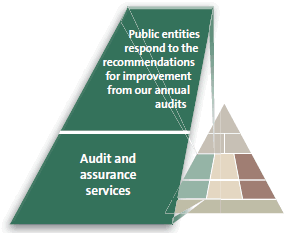
Figure 11
Summary of impacts and outputs for Audit and assurance services
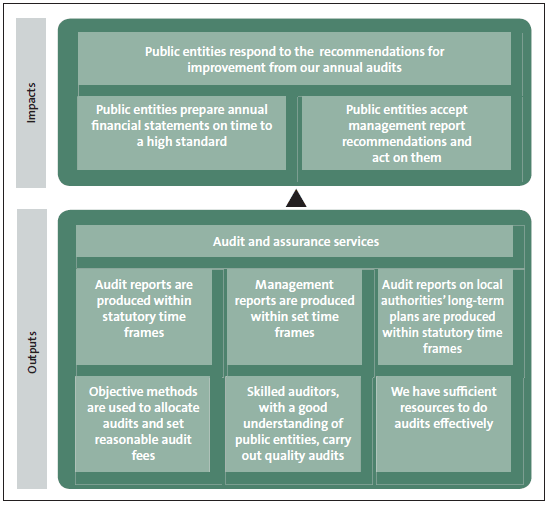
Impact and output measures and standards, and previous performance, for Audit and assurance services
| Public entities respond to the recommendations for improvement from our annual audits |
| Measure: Central government entities' management control environment (MCE), financial information (FISC), and service performance information systems and controls (SPIASC) are improved (or at least maintained), measured against the previous two years. Comment: We aim to contribute to improved financial and service performance reporting and improved performance management in public entities. We report our observations to entities on their MCE, FISC, and SPIASC, and assign grades accordingly: Very Good, Good, Needs Improvement, or Poor. Movements in the grades provide an indication of whether entities are accepting and responding to our recommendations, and improving their systems and controls. Results: Results for the previous four years are shown in Figures 12 to 14. Comment: Figures 12 to 14 show the year-end period for which the audit is carried out. The 2012/13 audits and associated grades are completed during 2013/14. |
Figure 12
Grade percentages by year for management control environment (MCE), 2008/09, 2009/10, 2010/11, and 2011/12
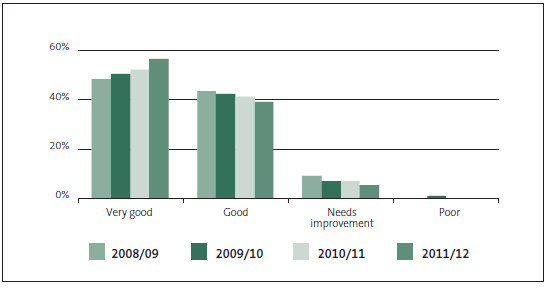
Figure 13
Grade percentages by year for financial information systems and controls (FISC), 2008/09, 2009/10, 2010/11, and 2011/12
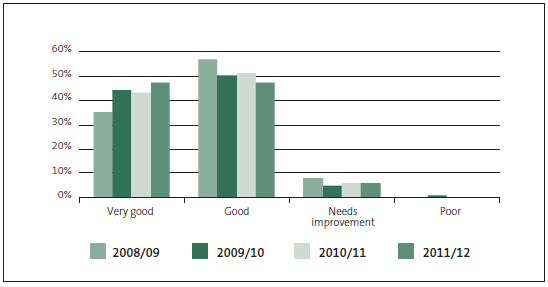
Figure 14
Grade percentages by year for service performance information and associated systems and controls (SPIASC), 2008/09, 2009/10, 2010/11, and 2011/12

| Public entities prepare financial statements on time to a high standard |
| Measure: The percentage of public entities' audited financial reports containing modified audit opinions is reduced (or at least maintained), measured against the previous two years. Results: Results for the previous five years and the target for 2013/14 to 2015/16 are shown in Figure 15. |
Figure 15
Percentage of audited financial reports that contain modified audit opinions

| Public entities accept management report recommendations and act on them |
| Measure: Public entities' acceptance of audit service providers' management report recommendations is at least maintained, measured against the previous two years. Comment: We set a 75% target for the percentage of management report recommendations accepted by public entities. Our experience shows that management quite reasonably will sometimes have different views to the Auditor, and may not act on all recommendations. For the year ended 30 June 2012, we assessed a sample of 40 entities with audit fees greater than $50,000 against this performance measure. Before 2011, this was only assessed against a sample of Audit New Zealand's management report recommendations. Results: Results for the previous five years and the target for percentage of accepted management recommendations are shown in Figure 16. |
Figure 16
Percentage of management report recommendations accepted by public entities
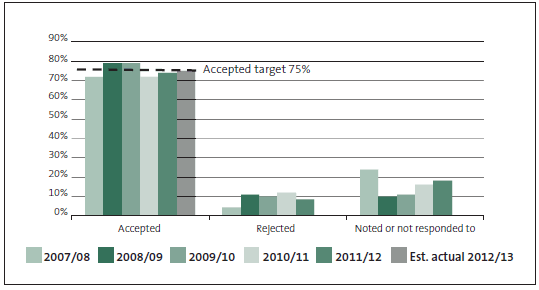
| Audit reports are produced within statutory time frames |
| Measure: The percentage of public entities' audited financial reports issued within the statutory time frame is improved (or at least maintained), measured against the previous two years. Results: Results for the previous five years and the target for 2013/14 to 2015/16 are shown in Figure 17. |
Figure 17
Percentage of audited financial reports issued on time
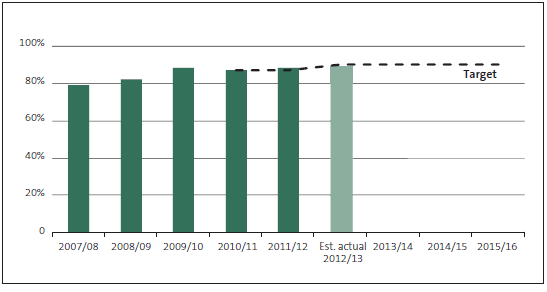
| Measure: Less than 30% of the audit reports outstanding at 30 June are because of inaction on our part. Results: Results for the previous five years and the target for 2013/14-2015/16 are shown in Figure 18. |
Figure 18
Percentage of audit reports outstanding at 30 June because of our inaction
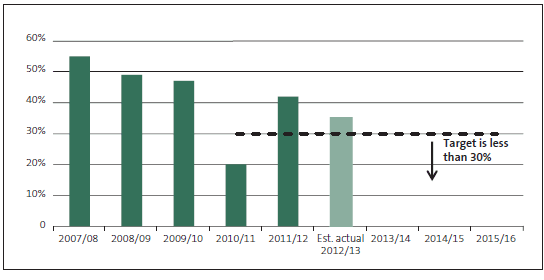
| Management reports are produced within set time frames |
| Measure: All management reports are issued within six weeks of issuing the audit report. Results: Results for the previous five years and the target for 2013/14 to 2015/16 are shown in Figure 19. |
Figure 19
Percentage of management reports issued within six weeks
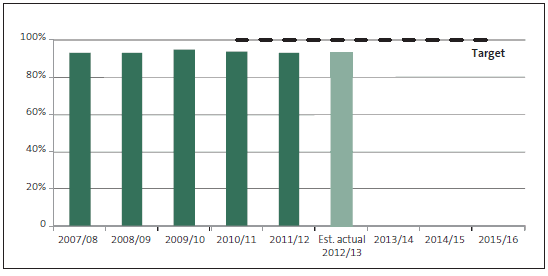
| Audit reports on local authorities' long-term plans are produced within statutory time frames |
| Measure: No long-term plan (LTP) audit opinions outstanding at 30 June of the year in which LTPs are to be adopted by local authorities are because of inaction on our part. Results: In 2011/12, there were no LTP audit opinions outstanding at 30 June because of inaction on our part. Comment: LTP audits are carried out every three-years. The last LTP audits were carried out in 2011/12, and the next opinions will be issued in 2014/15. For the 2012-22 LTPs, 94% of local authorities adopted their final LTP within the statutory deadline. Four local authorities completed their responsibilities after 30 June. Christchurch City Council originally obtained a one-year extension due to the Canterbury earthquakes. Then, in March 2013, the requirement for Christchurch City Council to complete an LTP for the nine years commencing 1 July 2013 was suspended, and the Council will now produce and adopt a new planning document – a three-year plan for which there is no audit requirement. The next LTP opinion for Christchurch City Council will be issued in 2014/15. |
| Measure: All LTP management reports are issued within six weeks of issuing the LTP audit opinion. Results: 82% of management reports were issued within six weeks of issuing the LTP audit opinion. |
| Objective methods are used to allocate audits and set reasonable audit fees |
| Measure: An annual independent review of our processes confirms the probity and objectivity of the methods and systems we use to allocate and tender audits, and monitor the reasonableness of audit fees. Result: Results from reviews for the previous five years confirm we achieved our forecast standard. |
| Skilled auditors, with a good understanding of public entities, carry out quality audits |
| Measure: Client satisfaction survey results show that, overall, 85% of respondents are satisfied with the quality of audit work (including the expertise of staff and the quality of the public entity's relationship with their audit service provider). Results: Results for the previous five years and the target for 2013/14 to 2015/16 are shown in Figure 20. |
Figure 20
Percentage of clients satisfied with the quality of audit work
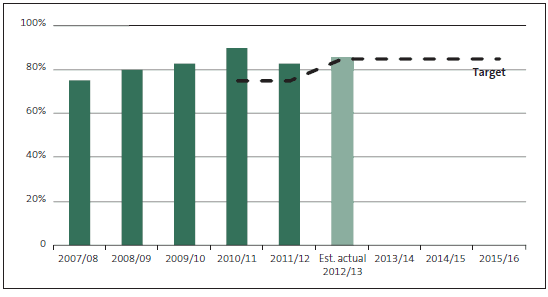
| Measure: Quality assurance reviews for all appointed auditors are completed during a three-year period. Of the auditors reviewed in any given year, 100% achieve a grade of "satisfactory" or better. Results: Results for the previous five years and the target for 2013/14 to 2015/16 are shown in Figure 21. |
Figure 21
Percentage of auditors achieving a grade of satisfactory or better from quality assurance reviews
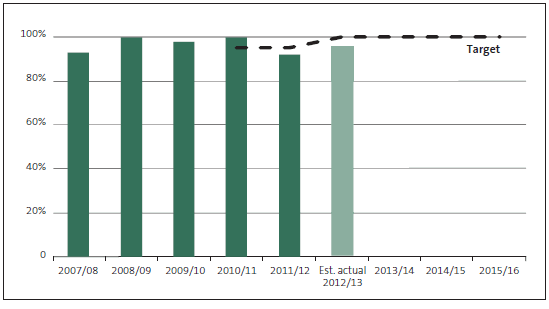
| We have sufficient resources to do audits effectively |
| Measure: The Officers of Parliament Committee accepts any significant proposals for an appropriation increase in audit fees and expenses. Result: No significant proposal was made for an appropriation increase in audit fees and expenses in 2009/10, 2010/11, and 2011/12. |
Multi-class output: Statutory auditor function
This multi-class output includes the following:
- Services to Parliament – providing advice and assistance to select committees and other stakeholders;
- Controller function – providing assurance to Parliament that spending has been properly incurred with Parliament's appropriations; and
- Reports, studies, and inquiries – reporting on the results of annual audits, performance audits and other studies and inquiring into a public entity's use of its resources.
Services to Parliament
We provide advice and assistance to Parliament and to other stakeholders through:
- reports and advice to select committees to assist their financial reviews of government departments and Offices of Parliament, State-owned enterprises, and some Crown entities and to assist Select Committees with their examination of the Estimates of Appropriations;
- reporting to responsible Ministers on the results of the annual audits and to Parliament and other constituencies on matters arising from our annual audits;
- responding to requests and participating in working parties on matters related to financial management and accountability with stakeholders, including government departments, central agencies, local authorities, professional bodies, sector organisations, and other public entities; and
- working with Auditors-General in other countries to encourage, promote, and advance capability and co-operation in the field of public audit. We will continue to support good governance and accountability in the Pacific through our role as Secretariat of the Pacific Association of Supreme Audit Institutions (PASAI), and the Auditor-General's representation of the PASAI region on the governing board of the International Organisation of Supreme Audit Institutions (INTOSAI). We are members of various committees of INTOSAI, including the Professional Standards Steering Committee, and we expect to continue our involvement in chairing various working groups tasked with developing guidance for supreme audit institutions.
Controller function
The Controller function of the Controller and Auditor-General provides independent assurance to Parliament that expenses and capital expenditure of government departments and Offices of Parliament have been incurred for purposes that are lawful and within the scope, amount, and period of the appropriation or other authority.
The OAG and appointed auditors carry out standard procedures to give effect to the Controller function in keeping with the Auditor-General's auditing standards and a Memorandum of Understanding with the Treasury. This involves reviewing monthly reports provided by the Treasury, and advising the Treasury of any issues arising and the action to be taken.
Reports, studies and inquiries
Each year, we publish around 20 reports on the results of our annual audits, performance audits, major inquiries, and other studies. Through this reporting to Parliament and other stakeholders we consider matters related to the use of resources in greater depth than is appropriate within the statutory scope of an annual audit and look for ways that public entities can perform better.
We usually receive around 200 to 300 requests for inquiries annually, spanning a wide range of concerns about central and local government entities. The Auditor-General also administers the Local Authorities (Members' Interests) Act 1968, which regulates pecuniary interest questions in the local government sector. Each year, we usually receive 50 to 100 enquiries under that Act.
Our focus
In our Statutory auditor function work in 2013/14, we will focus on:
- Public sector service delivery – Building on our previous work, we will report to Parliament on how well the public sector is responding to the need to deliver improved services for less through changing service delivery structures, models and methods.
- Performance information – We will continue to provide advice to parliamentary select committees on how to use performance information from government departments and Crown entities to assess and enquire into effectiveness and efficiency, particularly in a cost-constrained environment. We will also continue to liaise with government departments and Crown entities to help them improve their performance information and use it to consider effectiveness and efficiency.
- Sharing sector knowledge – We will make further progress on the better use and presentation of information about sectors within the public sector to Parliament, select committees, and public entities.
Our impacts and outputs for multi-class output Statutory auditor function are summarised in Figure 22. Details of our measures and standards for this multi-class output, and our previous performance, are shown in the pages after Figure 22.
The Vote estimate for multi-class output Statutory auditor function in 2013/14 is $9.322 million.
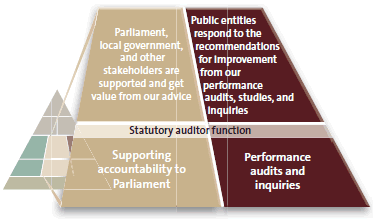
Figure 22
Summary of impacts and outputs for Statutory auditor function
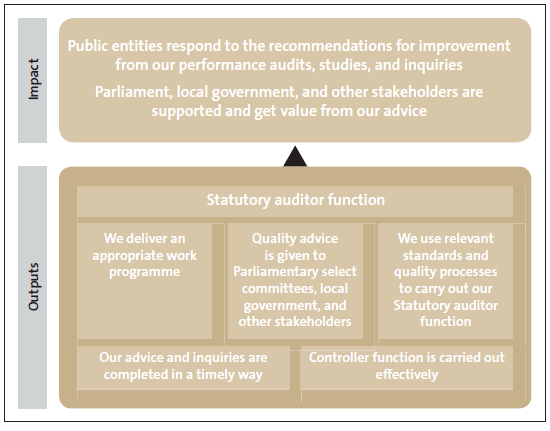
Impacts and output measures and standards, and previous performance, for Statutory auditor function
|
Measures:
|
Figure 23
Percentage of select committee members who confirmed that our advice assists them in Estimates of Appropriations and financial review examinations

| We deliver an appropriate work programme |
| Measure: Select committees and other stakeholders are satisfied with the proposed work programme (as indicated by feedback on our draft annual work programme). Results: 2012 – Feedback received from select committees and other stakeholders mainly supported our proposed work programme, and enabled us to clarify the proposed scope of some specific pieces of work. 2011 – Feedback received from select committees and other stakeholders mainly supported our proposals and approach, with a specific suggestion that in future years we look at the performance of the New Zealand Police in road safety enforcement. 2007 to 2010 – Feedback received from select committees and other stakeholders mainly supported our proposals and approach. |
| Quality advice is given to Parliamentary select committees, local government, and other stakeholders |
Measures:
|
| We use relevant standards and quality processes to carry out our Statutory auditor function |
Measures:
|
| Our advice and inquiries are completed in a timely way |
Measures:
|
Figure 24
Percentage of findings on routine inquiries reported to relevant parties within three months and on significant inquiries reported to the relevant parties within six months

Figure 25
Number of findings on major inquiries reported to relevant parties within 12 months
| Year | Completed major inquiries | Reported within 12 months |
|---|---|---|
| 2012 | 1 | 1 |
| 2011 | 3 | 1 |
| 2010 | 5 | 4 |
| 2009 | 2 | Both reported within 13 months |
Figure 26
Percentage of enquiries under the Local Authorities (Members' Interests) Act 1968 completed within 30 working days
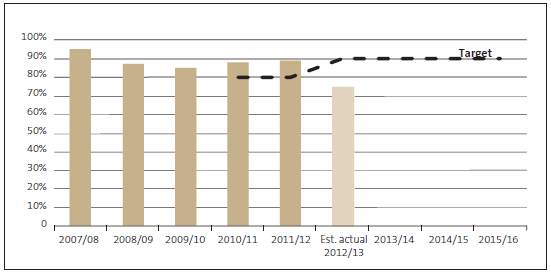
| Controller function is carried out effectively |
| Measure: Monthly statements provided by the Treasury are reviewed for the period September to June inclusive. Advice of issues arising and action to be taken is provided to the Treasury and appointed auditors within five working days of receipt of the statement. Results: 2007–2012 – All monthly procedures were followed and agreed time frames achieved. |
5: Our expectation is based on information as at 15 February 2013.
page top